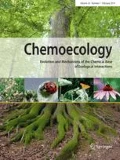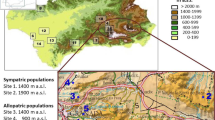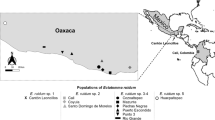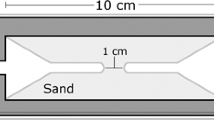Summary.
Proformica longiseta exists as two populations in the Sierra Nevada Mountains in Spain, only one of which is parasitized by the slave-maker ant Rossomyrmex minuchae. To investigate the possible effect of co-evolutionary pressures on cuticular hydrocarbon (CHC) profiles (the presumed nestmate recognition cues), we performed a comparative analysis of the CHC of R. minuchae and P. longiseta colonies from both the allopatric and sympatric populations; the latter includes samples of enslaved as well as free-living workers. Discriminant analyses based on these chemical profiles showed two clear profile groups: the first comprised R. minuchae and both enslaved and free-living P. longiseta from the sympatric population; and the second the allopatric P. longiseta workers. As expected, the profiles of the two sympatric P. longiseta groups (enslaved and free-living) were distinct; but, interestingly, those of the enslaved P. longiseta and its parasite R. minuchae were also distinguishable. This indicates that despite their cohabitation each species maintains its own chemical identity. Profile similarity between the sympatric free-living P. longiseta and its parasite may explain the lower than expected aggression observed during raids. We further speculate that in view of the differences between the sympatric and allopatric population of P. longiseta, co-evolutionary pressures have driven changes in the profile of the former to better match that of its parasite R. minuchae. Such an adjustment may have enabled nests of the sympatric P. longiseta to endure multiple raids by the parasite (due to the reduced aggression) and thus to continue to reproduce despite the damage inflicted by the raids.
Similar content being viewed by others
Author information
Authors and Affiliations
Corresponding author
Rights and permissions
About this article
Cite this article
Errard, C., Ruano, F., Richard, FJ. et al. Co-evolution-driven cuticular hydrocarbon variation between the slave-making ant Rossomyrmex minuchae and its host Proformica longiseta (Hymenoptera: Formicidae). Chemoecology 16, 235–240 (2006). https://doi.org/10.1007/s00049-006-0358-4
Received:
Accepted:
Issue Date:
DOI: https://doi.org/10.1007/s00049-006-0358-4




